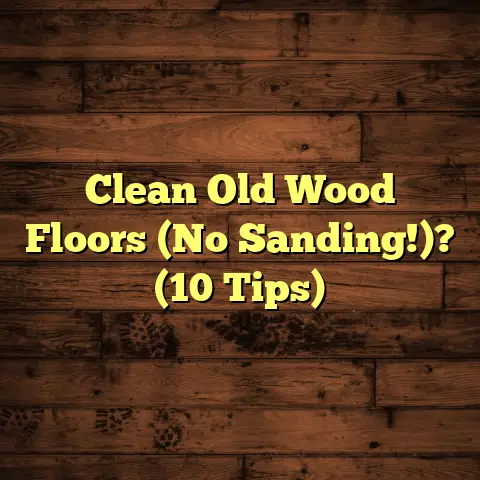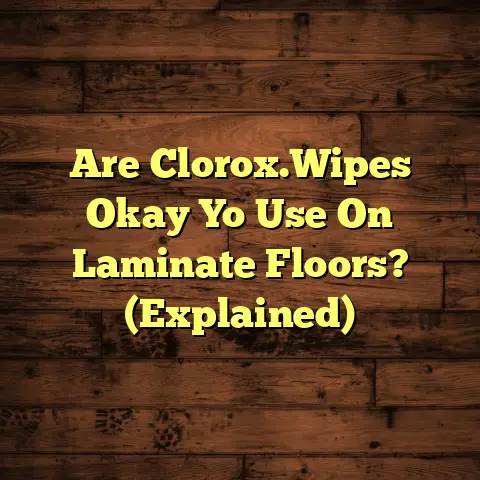PVC Safe for LVP Flooring? (Read BEFORE You Buy!)
Imagine stepping into a beautifully designed living room where the warm glow of sunlight filters through large windows, casting playful shadows on the strikingly elegant floor beneath your feet.
The floor, a seamless expanse of luxury vinyl plank (LVP), combines the rich texture of hardwood with the resilience of modern materials.
As you walk across it, you can hardly believe
it’s not solid wood.
This is the allure of LVP
– a flooring option that has surged in
popularity in recent years for its stunning
appearance and practical benefits.
However, lurking beneath this beauty is a critical question that every potential buyer should consider: Is PVC safe for LVP flooring?
Introduction
In the world of flooring, luxury vinyl plank (LVP) has become a go-to solution for homeowners and designers looking for a balance between aesthetics and functionality.
With its ease of installation, maintenance, and incredible versatility, LVP has gained traction as a flooring choice.
However, the materials that make up this popular option, particularly polyvinyl chloride (PVC), have sparked debates regarding safety and environmental impact.
As a flooring contractor with years of
experience, I’ve seen firsthand how LVP can
transform a space.
But I also understand the
importance of knowing what’s in your
flooring.
This article aims to explore the relationship between PVC and LVP flooring, addressing significant concerns about health risks, environmental implications, and the overall safety of purchasing and installing LVP products.
As consumers become increasingly aware of the materials that populate their homes, understanding the role of PVC in LVP will help make informed decisions that align with personal values regarding health and sustainability.
So, let’s dive in and get to the bottom of this!
1. Understanding LVP Flooring
Definition and Composition of LVP
So, what exactly is LVP flooring?
Simply put, it’s a multi-layered synthetic flooring product designed to mimic the look of natural materials like hardwood, stone, or ceramic tile.
Think of it as a high-tech laminate, but with better water resistance and a more realistic appearance.
Typically, LVP consists of several layers:
Wear Layer: This is the top layer, designed to protect the floor from scratches, stains, and wear and tear. The thicker the wear layer, the more durable the flooring.
Print Layer: This layer provides the visual design, replicating the appearance of wood, stone, or other materials.
Core Layer: This is the main structural component of the plank. It’s often made of PVC (polyvinyl chloride) or WPC (wood plastic composite).
Backing Layer: This bottom layer provides stability and helps prevent moisture from damaging the floor.
Popularity of LVP in Modern Home Design
Why is LVP so popular these days? Well, there are several reasons.
First off, it’s incredibly versatile.
LVP can
be used in almost any room of the house,
including kitchens, bathrooms, and basements,
where moisture is a concern.
Second, it’s relatively easy to install,
especially the click-lock versions.
I’ve seen
plenty of DIYers successfully install LVP
themselves, saving a ton of money on
installation costs.
And finally, it looks great!
With advances in
printing technology, LVP can now convincingly
replicate the look and feel of natural
materials.
Benefits of LVP Flooring
Let’s break down the key benefits of LVP:
Water Resistance: Unlike hardwood, LVP is highly water-resistant, making it ideal for kitchens, bathrooms, and basements.
Durability: LVP is designed to withstand heavy foot traffic and resist scratches, stains, and dents.
Ease of Maintenance: Cleaning LVP is a breeze. Just sweep, mop, or vacuum regularly.
Cost-Effectiveness: LVP is generally more affordable than hardwood or stone flooring.
Versatility: LVP comes in a wide range of styles, colors, and patterns to suit any decor.
Easy Installation: Many LVP products feature a click-lock system, making them easy to install without glue or nails.
2. The Role of PVC in LVP
What is PVC?
Okay, let’s talk about PVC.
Polyvinyl chloride (PVC) is a synthetic
plastic polymer.
It’s one of the most widely
produced plastics in the world, used in
everything from pipes and window frames to
clothing and medical devices.
PVC is made by polymerizing vinyl chloride
monomer (VCM).
The resulting polymer is rigid
and brittle, so manufacturers add plasticizers
to make it more flexible and durable.
How is PVC Used in the Manufacturing of LVP?
In LVP flooring, PVC is primarily used in the
core layer.
It provides the floor with its
structural stability, water resistance, and
durability.
The amount of PVC in LVP can vary depending on
the product and manufacturer.
Some LVP
products use a solid PVC core, while others
use a composite core that includes PVC and
other materials like wood flour or limestone.
The Advantages of Using PVC in LVP Flooring
So, why do manufacturers use PVC in LVP?
Well, it offers several advantages:
Water Resistance: PVC is naturally water-resistant, making LVP suitable for moisture-prone areas.
Durability: PVC is a strong and durable material that can withstand heavy foot traffic and resist wear and tear.
Cost-Effectiveness: PVC is relatively inexpensive to produce, making LVP more affordable than other flooring options.
Versatility: PVC can be easily molded and shaped, allowing manufacturers to create a wide range of LVP designs and styles.
3. Health Concerns Related to PVC
Overview of Concerns Associated with PVC Products
Now, let’s address the elephant in the room: the health concerns associated with PVC.
PVC has been the subject of controversy for years due to concerns about the chemicals used in its production and the potential for harmful substances to leach out of the material over time.
Some of the main concerns include:
Vinyl Chloride: VCM, the building block of PVC, is a known human carcinogen. Exposure to high levels of VCM can cause liver cancer, brain cancer, and other health problems.
Phthalates: These are plasticizers added to PVC to make it more flexible. Some phthalates have been linked to hormone disruption, reproductive problems, and developmental issues.
Dioxins: These are highly toxic byproducts of PVC production and incineration. Dioxins can accumulate in the environment and cause cancer, immune system problems, and other health effects.
Discussion of Volatile Organic Compounds (VOCs) and Other Chemicals
Another concern with PVC flooring is the potential for it to release volatile organic compounds (VOCs) into the air.
VOCs are chemicals that evaporate at room
temperature.
They can cause a range of health
problems, including headaches, dizziness,
nausea, and respiratory irritation.
Some common VOCs found in PVC flooring include:
Formaldehyde: A known carcinogen that can cause respiratory problems and eye irritation.
Benzene: A solvent that can cause headaches, dizziness, and nausea.
Toluene: A solvent that can cause headaches, dizziness, and fatigue.
Potential Health Risks Linked to PVC Exposure
So, what are the potential health risks associated with PVC exposure?
Well, it depends on the level and duration of exposure, as well as individual factors like age, genetics, and overall health.
Some of the potential health risks include:
Respiratory Problems: VOCs released from PVC flooring can irritate the respiratory system and trigger asthma attacks.
Allergic Reactions: Some people may be allergic to PVC or the chemicals used in its production.
Hormone Disruption: Phthalates in PVC can interfere with the endocrine system and cause hormone imbalances.
Cancer: Long-term exposure to VCM and dioxins can increase the risk of cancer.
4. Environmental Impact of PVC
Production Processes of PVC and Their Ecological Footprint
The production of PVC has a significant environmental impact.
The process involves the extraction of raw materials like chlorine and ethylene, which are then converted into VCM and polymerized to form PVC.
This process requires a lot of energy and generates a significant amount of waste.
Furthermore, the production of PVC can release harmful pollutants into the air and water, including dioxins, mercury, and other toxic chemicals.
End-of-Life Considerations: Recycling and Disposal of PVC
Another environmental concern with PVC is its end-of-life management.
PVC is difficult to recycle, and most PVC waste ends up in landfills or incinerators.
When PVC is incinerated, it can release dioxins and other harmful pollutants into the air.
Landfilling PVC can also be problematic, as the material can leach chemicals into the soil and groundwater over time.
Comparison of PVC with Alternative Materials Used in Flooring
Are there alternatives to PVC in flooring?
Absolutely!
Several alternative materials can be used in LVP and other types of flooring.
Some popular options include:
WPC (Wood Plastic Composite): This material is made from a blend of wood flour and plastic. It’s more environmentally friendly than PVC, but it may not be as water-resistant.
SPC (Stone Plastic Composite): This material is made from a blend of limestone and plastic. It’s very durable and water-resistant, but it can be more expensive than PVC.
Linoleum: This natural material is made from linseed oil, wood flour, and other renewable resources. It’s biodegradable and doesn’t release harmful VOCs.
Cork: This natural material is harvested from the bark of cork trees. It’s sustainable, renewable, and has excellent insulating properties.
Here’s a quick comparison table:
5. Regulatory Standards and Certifications
Overview of Regulations Governing PVC in Flooring Products
Fortunately, there are regulations in place to limit the use of harmful chemicals in PVC flooring products.
In the United States, the Consumer Product Safety Commission (CPSC) regulates the use of certain chemicals in consumer products, including flooring.
The European Union has even stricter regulations on PVC, including restrictions on the use of phthalates and other harmful substances.
Explanation of Certifications that Ensure Safety (e.g., FloorScore, GreenGuard)
One of the best ways to ensure that your LVP flooring is safe is to look for products that have been certified by independent organizations.
Some of the most common certifications include:
FloorScore: This certification ensures that flooring products meet strict VOC emission limits.
GreenGuard: This certification ensures that products have low chemical emissions and are safe for indoor use.
UL GREENGUARD Gold: Offers stricter certification criteria and considers safety factors to account for sensitive individuals (such as children and the elderly).
CARB Phase 2 Compliant: Ensures that composite wood products meet formaldehyde emission standards.
The Importance of Choosing Certified LVP Products
When you choose certified LVP flooring, you can be confident that the product has been tested and meets strict safety standards.
This can help reduce your exposure to harmful chemicals and protect your health.
I always recommend my clients to look for
these certifications when selecting LVP
flooring.
It’s a small step that can make a
big difference.
6. Consumer Perspectives and Experiences
Testimonials from Homeowners Regarding Their Experiences with LVP Flooring
I’ve installed LVP in countless homes over the years, and I’ve heard a wide range of opinions from homeowners.
Some people absolutely love it, praising its durability, water resistance, and ease of maintenance.
Others are more hesitant, expressing concerns about the potential health risks associated with PVC.
Here are a few testimonials I’ve gathered over the years:
“I love my LVP flooring! It looks great, it’s easy to clean, and it’s held up really well to my kids and pets.” – Sarah, homeowner
“I was a little worried about the PVC at first, but I did my research and chose a FloorScore-certified product. I’m very happy with my decision.” – John, homeowner
“I had LVP installed in my basement, and it’s been a lifesaver. It’s completely waterproof, so I don’t have to worry about flooding.” – Mary, homeowner
Case Studies of Projects that Utilized PVC-Based LVP
Let’s look at a couple of case studies:
The Johnson Residence: A young family with two small children chose LVP for their kitchen and bathrooms. They were concerned about water damage and wanted a durable, easy-to-clean flooring option. They opted for a FloorScore-certified product and have been very happy with their choice.
The Smith Office: A small business installed LVP in their office space. They wanted a cost-effective flooring option that could withstand heavy foot traffic. They chose a product with a thick wear layer and have been pleased with its durability.
Insights from Industry Experts on the Safety and Efficacy of LVP
I’ve also spoken with several industry experts about the safety and efficacy of LVP flooring.
The consensus is that LVP is generally safe, as long as you choose a product that meets relevant safety standards and is installed properly.
However, it’s important to be aware of the potential health risks associated with PVC and to take steps to minimize your exposure.
7. Making an Informed Decision
Key Questions to Ask When Considering LVP Flooring
So, you’re considering LVP flooring?
Here are some key questions to ask before you make a purchase:
What is the core material? Is it PVC, WPC, or SPC?
Does the product have any certifications? Look for FloorScore, GreenGuard, or other relevant certifications.
What is the wear layer thickness? The thicker the wear layer, the more durable the flooring.
What is the VOC emission level? Choose a product with low VOC emissions.
What is the warranty? A good warranty can protect you against defects and premature wear.
How to Evaluate the Safety of LVP Products Before Purchase
Here are some tips for evaluating the safety of LVP products:
Read the product label carefully. Look for information about the materials used in the flooring and any potential health risks.
Check for certifications. Look for FloorScore, GreenGuard, or other relevant certifications.
Ask the manufacturer for a safety data sheet (SDS). This document provides detailed information about the chemicals used in the product and any potential health hazards.
Consider alternative materials. If you’re concerned about PVC, consider WPC, SPC, linoleum, or cork flooring.
Resources for Consumers to Further Educate Themselves on PVC and LVP
Here are some resources for consumers to further educate themselves on PVC and LVP flooring:
The Vinyl Institute: This industry association provides information about the benefits and safety of PVC.
The Healthy Building Network: This non-profit organization provides information about the health and environmental impacts of building materials.
The U.S. Environmental Protection Agency (EPA): The EPA provides information about indoor air quality and the health risks associated with VOCs.
Green Building Certification Programs: Organizations like LEED and Green Globes offer resources and standards for environmentally friendly building practices and materials.
8. Conclusion
Summary of Findings Regarding the Safety of PVC in LVP Flooring
So, is PVC safe for LVP flooring?
The answer is complex.
PVC itself is not inherently dangerous, but the chemicals used in its production and the potential for VOC emissions can pose health risks.
However, by choosing certified LVP flooring and taking steps to minimize your exposure, you can reduce these risks and enjoy the benefits of this versatile and affordable flooring option.
Final Thoughts on Making a Well-Informed Decision Regarding Flooring Choices
Ultimately, the decision of whether or not to use LVP flooring is a personal one.
It’s important to weigh the pros and cons, do your research, and choose a product that you feel comfortable with.
I hope this article has provided you with the information you need to make a well-informed decision.
Remember, knowledge is power!
By understanding the role of PVC in LVP flooring, you can make a choice that’s right for your health, your home, and the environment.
Good luck with your flooring project!





